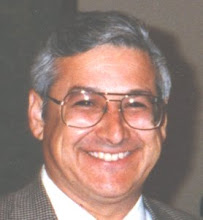
1. European/African/Middle Eastern Campaign Medal:
Awarded for Service during a time span of 07Dec1941 to 08Nov1945.
It has a Tiny Bronze Star which denotes participation in military campaigns in either of the following:
Rhineland 15 Sep 44 - 21 Mar 45;
Ardennes-Alsace 16 Dec 44 - 25 Jan 45;
Central Europe 22 Mar 45 - 11 May 45.
He served in all these sites while stationed in Europe.
The medal shows an LST landing craft and troops landing under fire with an airplane in the background. Green, white, and red are the Italian colors. The white and black colors represent Germany. The United States colors are in the center of the ribbon. The brown and green areas of the ribbon represent the terrain of the area of conflict, which ranged from beaches and sand, to grass and woodlands, to mountains.

2. Army of Occupation Medal:
Awarded for serving at least thirty consecutive days while assigned in Germany during the time span of 09May1945 and 05May1955. His has a campaign clasp for 'Germany'.
The bridge on the medal was the Ludendorff railroad bridge at Remagen, Germany and was situated 22 miles northwest of Koblenz. On March 7, 1945, the Allies established their first bridgehead across the Rhine by seizing the Ludendorff railroad bridge at Remagen before the Germans could destroy it. Since this bridge was "point of entry" of ground forced into Germany, it was selected to represent the occupation of Germany.
The red and white represent Japan and the black and white represent Germany, the primary opponents of the United States during the Second World War.

3. WWII Victory Medal:
Awarded for service during the time span of 07Dec1941 and 31Dec1946.
The medal has a figure of Liberation standing full length with head turned to dexter looking to the dawn of a new day, right foot resting on a war god’s helmet with the hilt of a broken sword in the right hand and the broken blade in the left hand. The rainbow on each side of the ribbon is a miniature of the pattern used in the WWI Victory Medal. The rainbows were selected to represent a "new era" and the calm after a storm.

4. National Defense Service Medal:
All soldiers who served honorably in active service as a member of the Armed Forces even now receive the National Defense Service Medal. Emeterio was awarded this medal as well.
The medal shows an eagle with inverted wings standing on a sword and palm branch which signify strength and preparedness.








